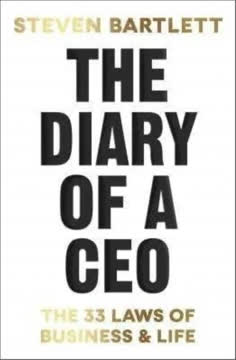Key Takeaways
1. Managing is a Practice, Not Just Leadership or a Science
Management as a practice, not a profession.
Beyond the myths. Management has been overshadowed by the focus on heroic leadership, often portrayed as separate and superior. This book argues that leadership is simply management practiced well, and we are currently "overled and undermanaged." We need to understand the realities of managing itself, which is crucial for everyone affected by it.
Not a science or profession. Unlike engineering or medicine, managing is not reliably codified or certified. It cannot be taught effectively out of context in a classroom alone. While managers use science (analysis), effective managing relies heavily on art (intuition, vision) and, most importantly, craft (learning from experience).
Rooted in context. Managing is fundamentally a practice learned on the job, deeply embedded in specific situations. There is no universal "one best way" to manage. The best managers often haven't spent years in management classrooms, highlighting that practical experience and context-specific knowledge are paramount.
2. Managerial Work is Relentlessly Hectic and Fragmented
Study after study has shown that (a) managers work at an unrelenting pace; (b) their activities are characterized by brevity, variety, and fragmentation, and (c) they are strongly oriented to action.
A constant rush. Contrary to the myth of the reflective planner, managers operate at a relentless pace, constantly interrupted and jumping between diverse tasks. This reality has been consistently observed for decades, from foremen to CEOs. The job is "one damn thing after another."
Brevity and variety. Managerial activities are typically short and varied, with little time for sustained concentration. Managers often prefer this pace, partly to stay informed and partly because the job's open-ended nature creates a perpetual sense of unfinished work. This leads to a sensitive appreciation for the opportunity cost of their time.
Action orientation. Managers favor tangible, current, and non-routine activities. They prefer concrete issues over abstract debates and prioritize current information, even if less reliable, for its timeliness. Planning often happens implicitly through daily actions rather than in formal, abstract processes.
3. Managers Operate Across Three Interconnected Planes: Information, People, and Action
Managing is described as happening on three “planes”: through information, with people, and for action.
A holistic view. Instead of seeing managing as a collection of separate roles (like planning, organizing, leading), it's better understood as an integrated whole operating on three interconnected planes. Managers work:
- Through information (processing data to guide others)
- With people (interacting to enable others)
- For action (getting things done directly or indirectly)
Balancing the planes. Effective managing requires operating on all three planes simultaneously. Focusing too much on one plane leads to imbalance:
- Information-heavy: Detached, focused on metrics over reality.
- People-heavy: Aimless, lacking direction or tangible results.
- Action-heavy: Micromanaging, failing to leverage others.
Framing and scheduling. Underlying these planes are framing (defining purpose, strategy, priorities) and scheduling (allocating time and attention). Scheduling brings the frame to life and signals priorities, while the frame provides coherence to the fragmented activities.
4. Information Flow Favors Soft, Oral, and Visual Communication
The manager is the relative generalist in the unit, overseeing the more specialized jobs.
Beyond formal reports. Managers rely heavily on informal communication, such as meetings, phone calls, and e-mail, which constitute 60-90% of their contact time. Formal reports are often ignored or seen as "paper ballast." Managers cherish "soft" information like gossip, hearsay, and speculation for its timeliness.
The nerve center. By virtue of their position and constant communication, managers become the nerve centers of their units, possessing a broad overview of internal operations and external events. They monitor, disseminate information internally, and act as spokespersons externally.
Visual and visceral. Much crucial information is not even verbal but visual (what is seen) and visceral (what is felt). Effective managers pick up on non-verbal cues like tone of voice, facial expressions, and body language. This highlights the limitation of purely electronic communication like e-mail, which lacks this richness.
5. Managing Involves Extensive Lateral Linking Beyond the Hierarchy
Managing is as much about lateral relationships among colleagues and associates as it is about hierarchical relationships up and down some hierarchy.
Beyond superior-subordinate. The traditional focus on hierarchical relationships ("superior" and "subordinate") is misleading. Managers spend a significant amount of time—often half or more—interacting laterally with colleagues, partners, suppliers, customers, and other external stakeholders.
The hourglass position. Managers sit like the neck of an hourglass, mediating between external networks and the internal unit. They build extensive networks of contacts for information, support, and collaboration. This linking role is crucial but often overlooked in management literature.
Buffering influence. Managers act as gatekeepers and buffers, controlling the flow of information and influence between the unit and the outside world. They must delicately balance protecting the unit from excessive pressure (dams, sponges) with ensuring it is responsive and aggressive when needed (sieves, hoses, drips).
6. Effective Managers Are Hands-On Doers and Dealmakers
In the doing role, the manager gets personally involved in the actions, “hands-on,” that determine what the unit gets done.
Getting things done. While managers work through others, they also engage directly in action. This involves "doing" within the unit (managing projects, handling disturbances) and "dealing" outside the unit (negotiating, building coalitions). This is about getting close to the action, not just giving orders.
Project management. Managers often get personally involved in projects to learn, demonstrate, or ensure desired outcomes. This hands-on involvement is crucial for learning and strategy formation; strategies often emerge from tangible experiences rather than being conceived in isolation.
Handling disturbances. Managers frequently react to unforeseen events, problems, or crises. They step in when issues fall between the cracks or require their unique authority, information, or external connections. Effective organizations not only avoid disturbances but also deal with unexpected ones effectively.
7. Managing Varies Immensely by Context, Not Just Level
No one size fits all in managing; there is no “one best way” to manage.
Context is king. Managerial work is highly varied, shaped by numerous factors beyond just the level in the hierarchy. These factors interact in complex ways, making it impossible to understand managing by looking at one factor in isolation.
Key sources of variety:
- External context: National culture, sector (business, government, health, plural), industry.
- Organizational nature: Form (entrepreneurial, professional, machine, project, missionary, political), age, size.
- Job specifics: Level in hierarchy, work supervised (function, project, staff).
- Temporary pressures: Crises, fashion.
- The person: Background, tenure, personal style.
Postures of managing. These interacting factors give rise to different "postures" managers adopt, such as maintaining the workflow, connecting externally, blending all around, remote controlling, fortifying the culture, intervening strategically, managing in the middle, managing out of the middle, and advising from the side. All managers may adopt most postures at some time, but tend to favor one based on job needs.
8. Effective Managing Blends Art, Craft, and Science
Effective managing requires some blend of art, craft, and science, whether in the person of the manager alone, or else in a management team that works together.
The necessary mix. While managing is not purely a science or an art, effective practice requires integrating elements of all three.
- Science: Provides order through systematic analysis and knowledge.
- Art: Brings in ideas, intuition, and vision.
- Craft: Roots the practice in tangible experience and learning by doing.
Avoiding imbalance. Over-relying on one element leads to dysfunctional styles:
- Too much science: Calculating, detached.
- Too much art: Narcissistic, self-absorbed.
- Too much craft: Tedious, resistant to new ideas.
Dynamic balance. Managers need to find a dynamic balance, tilting between these elements as the situation demands. This blend is crucial for navigating the complexities and nuances of the job and cannot be easily taught in a classroom; it is learned through experience and reflection.
9. Managing is Navigating Inescapable Conundrums and Tightropes
It is precisely the function of the executive … to reconcile conflicting forces, instincts, interests, conditions, positions and ideals.
Living with paradoxes. Managing is inherently full of paradoxes, dilemmas, and mysteries that cannot be resolved, only reconciled. Managers must constantly walk tightropes, balancing opposing forces and conflicting demands.
Examples of conundrums:
- Superficiality: Balancing depth with the pressure for speed.
- Planning: Thinking ahead in a hectic, unpredictable job.
- Decomposition: Finding synthesis in a fragmented world.
- Connecting: Staying informed when the job is inherently detached.
- Delegating: Sharing information when it's personal and oral.
- Measuring: Relying on numbers when they are limited and unreliable.
- Order: Bringing order when the job is disorderly.
- Control: Imposing order when managers above also impose order.
- Confidence: Being confident without becoming arrogant.
- Acting: Being decisive in an ambiguous world.
- Change: Managing change while maintaining continuity.
Reconciliation, not resolution. The key is not to eliminate these tensions but to manage them skillfully, weaving back and forth between the opposing sides. This requires judgment, nuance, and the ability to hold conflicting ideas simultaneously.
10. The Core Challenge is Balancing Superficiality with Depth
To be superficial is an occupational hazard of managerial work.
The pressure to act. The relentless pace and fragmentation of managerial work create a strong pull towards superficiality. Managers must process vast amounts of information and respond quickly, often without the time for deep analysis or reflection.
Proficiency in superficiality. Effective managers become proficient at handling complexity in small steps and quickly shifting focus. However, this must be balanced with the capacity for reflection—stepping back to ponder meaning and connect experiences to broader patterns.
Reflection fuels action. Reflection without action is passive, but action without reflection is thoughtless. Like great athletes who see the game slightly slower, effective managers can pause, even briefly, to make thoughtful maneuvers amidst pressure. This "refl'action" is crucial for navigating the job's inherent chaos.
11. Managerial Effectiveness is About the Right Match and Judgment, Not Perfection
Successful managers are flawed—we are all flawed—but their particular flaws are not fatal under the circumstances.
Flawed but functional. The idea of a perfect manager is a myth. All managers are flawed, but effective ones have flaws that are not fatal in their specific context. Success depends on the match between the person and the job, which changes over time.
Beyond simple metrics. Assessing managerial effectiveness is complex and cannot be reduced to simple measures like stock price. It requires judgment, considering:
- The effectiveness of the unit.
- The manager's contribution to that effectiveness (distinguishing from external factors).
- The broader impact beyond the unit and organization (e.g., social responsibility).
- The match between the manager's style/flaws and the context.
The return of judgment. Over-reliance on measurement has often replaced necessary judgment in assessing managers and organizations. Effective selection and assessment require understanding a candidate's flaws and judging their fit with the specific context, ideally with input from those they have managed.
12. The Future of Managing Lies in Engaged Communityship, Not Heroic Leadership
To be a successful manager, let alone—dare I say—a great leader, maybe you don’t have to be wonderful so much as more or less emotionally healthy and clearheaded...
Beyond the hero. Our obsession with heroic leadership is dysfunctional. It creates a reliance on saviors and demotes everyone else, fostering followers who need to be driven rather than leveraging people's natural propensity to cooperate.
Communityship over leadership. Organizations should be seen as communities of engagement, not mystical hierarchies. Managers are needed to coordinate and support, but they must work with people, not rule over them. This shift moves from controlling and empowering (which reinforce authority) to engaging and enabling.
Managing naturally. Effective managing is a perfectly natural act that we make unnatural by disconnecting it from its human and contextual roots. It's about being clearheaded, understanding limitations, appreciating others' potential, and being engaged to be engaging, connected to be connecting. This requires reasonably normal, emotionally healthy people, not superheroes.
Last updated:
Review Summary
Simply Managing receives mixed reviews, with an average rating of 3.64/5. Readers appreciate Mintzberg's refreshing perspective on management, challenging conventional leadership ideas. Many find the book insightful, offering valuable frameworks and quotes. However, some criticize its lack of actionable advice and outdated research. Positive aspects include the author's emphasis on practical experience, the balance of art, science, and craft in management, and the debunking of management myths. Criticisms focus on the book's structure, repetitiveness, and occasional lack of clarity.
Similar Books









Download PDF
Download EPUB
.epub digital book format is ideal for reading ebooks on phones, tablets, and e-readers.






